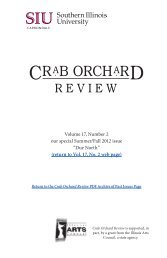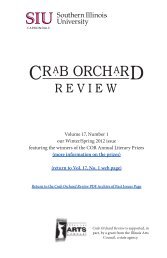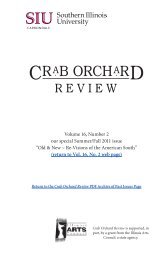- Page 1: CR A B ORCH A R• •R E V I E WDV
- Page 6 and 7: Crab Orchard Review wishes to expre
- Page 9: The editors and staff of Crab Orcha
- Page 12 and 13: Po e t r yDick Allen Small Hometown
- Page 14 and 15: Jake Adam York A Natural History of
- Page 16 and 17: The 2010 Ri c h a r d Pe t e r s o
- Page 19: Tabaré AlvarezThe Names of BambooT
- Page 23 and 24: Tabaré Alvareztwo men and the hous
- Page 25 and 26: Tabaré Alvarezhandle he realized w
- Page 27 and 28: Tabaré Alvarezhelp. In the end she
- Page 29 and 30: Tabaré Alvarezin their hands, sipp
- Page 31 and 32: Jamey GennaGoat HerderAileen was tr
- Page 33 and 34: Jamey Gennanow—only fourteen, Ail
- Page 35 and 36: Jamey GennaThe damn goat was so stu
- Page 37 and 38: Jamey Gennatraffic circle, and the
- Page 39 and 40: Jamey GennaAileen and Josie were ju
- Page 41 and 42: Dick Allengossiping or gardening. I
- Page 43 and 44: Jeffrey Beanto this place where not
- Page 45 and 46: Bruce Bondthe man of his unbearable
- Page 47 and 48: Bruce Bondshe understand of unspeak
- Page 49 and 50: Bruce BondWhere there is power, the
- Page 51 and 52: Heidi CzerwiecSpiral Jetty, Great S
- Page 53 and 54: B.K. FischerMaternity Bathing SuitN
- Page 55 and 56: Dionne IrvingCanalThere has been di
- Page 57 and 58: Dionne Irvingend of days. There are
- Page 59 and 60: Dionne Irvingand practiced strokes.
- Page 63: Dionne IrvingHe was trying hard to
- Page 66 and 67: Dionne Irving“Leave them,” he s
- Page 68: Janet McNallyFind Me an Animal with
- Page 72 and 73:
Janet McNallythe huge, pale pink bl
- Page 74 and 75:
Janet McNallymy hand and admired th
- Page 76 and 77:
Janet McNallyshe would stop for a m
- Page 78 and 79:
Janet McNallybe trying to make frie
- Page 80 and 81:
Janet McNallyWhen I return to my ho
- Page 82 and 83:
Carrie GreenCross-Pollination—DeL
- Page 84 and 85:
Carrie GreenThe Lue Gim Gong Grape/
- Page 86 and 87:
Carrie GreenThe Lue Gim Gong Seven-
- Page 88 and 89:
Carrie Greenand wither, petals fall
- Page 90 and 91:
Elizabeth HazenBurning TrashBoys st
- Page 92 and 93:
Luke JohnsonSurvey PhotographIcicle
- Page 94 and 95:
Luke JohnsonWidows PeakThe man may
- Page 96 and 97:
Rachel Meierable to convince her to
- Page 98 and 99:
Rachel MeierOn Thursday, she though
- Page 100 and 101:
Rachel Meierthe last insomniatic we
- Page 102 and 103:
Rachel Meierexhilarating and guilt-
- Page 104 and 105:
Rachel MeierTo Emma’s complete di
- Page 106 and 107:
Rachel Meiershe read easily and wit
- Page 108 and 109:
Rachel Meierunmistakable hum of a m
- Page 110 and 111:
Sarah NanceThe sheets at our hotel
- Page 112 and 113:
Sarah Nance“I miss the house too,
- Page 114 and 115:
Sarah NanceFor three mornings in a
- Page 116 and 117:
Sarah Nanceadopted a monarchy. June
- Page 118 and 119:
Sarah Nance“Why are you seeing he
- Page 120 and 121:
Sarah Nanceaged, even though my mot
- Page 122 and 123:
Sarah Nanceof June’s skirt. I loo
- Page 124 and 125:
Michael LevanStopped on a Train fro
- Page 126 and 127:
Michael LevanWalking through the We
- Page 128 and 129:
Angie MacriAxilsFrom Bee Branchto C
- Page 130 and 131:
Angie MacriThe March Down, Arkansas
- Page 132 and 133:
Tara McDanielMy Stepmother, Having
- Page 134 and 135:
Aimee NezhukumatathilInside a Diora
- Page 136 and 137:
James NolanAn Excerpt from Higher G
- Page 138 and 139:
James Nolanroofing nails, hear?”
- Page 140 and 141:
James Nolananymore. When she studie
- Page 142 and 143:
James NolanThen before she knew it,
- Page 144 and 145:
James Nolan“If one more thing goe
- Page 146 and 147:
James Nolan“Any kids?”“His,
- Page 148 and 149:
Shannon Sweetnamtoothbrush. It’s
- Page 150 and 151:
Shannon Sweetnamher purse, a duffel
- Page 152 and 153:
Shannon SweetnamAt home, that eveni
- Page 154 and 155:
Shannon Sweetnamthings he used to c
- Page 156 and 157:
Shannon Sweetnaminto bed. She think
- Page 158 and 159:
Shannon Sweetnamdance near the stag
- Page 160 and 161:
Shannon SweetnamGeorgian, ranch and
- Page 162 and 163:
Jonathan RiceColumbiaThe shuttle, u
- Page 164 and 165:
Jonathan RicePassoverWhen I heard y
- Page 166 and 167:
Jonathan Ricesold from under us—a
- Page 168 and 169:
Jonathan RiceThe Least of UsLightni
- Page 170 and 171:
J. Allyn RosserRoyal Dream, or Remi
- Page 172 and 173:
J. Allyn RosserSplit InfinitivesIt
- Page 174 and 175:
Carrie ShipersThe Dollmaker’s Dau
- Page 176 and 177:
Anya SilverThe Boy-Shaped PuzzleHow
- Page 178 and 179:
Anya SilverThe Ninety-Third Name of
- Page 180 and 181:
Brian SimoneauElegy with a Chance o
- Page 182 and 183:
Theresa D. SmithNocturne in Gray-Bl
- Page 184 and 185:
Brian M. BiggsDuring the Vietnam Wa
- Page 186 and 187:
Brian M. Biggsmouths, stood a few m
- Page 188 and 189:
Brian M. BiggsAt our marble-topped
- Page 190 and 191:
Brian M. Biggsseparated by more tha
- Page 192 and 193:
Brian M. BiggsEric didn’t call or
- Page 194 and 195:
Brian M. BiggsSaigon Government. Th
- Page 196 and 197:
Brian M. Biggs“Vietnamese people,
- Page 198 and 199:
Ryan TeitmanVespersPeel an orange,
- Page 200 and 201:
Ryan TeitmanComplineThere were no r
- Page 202 and 203:
Ryan TeitmanVigilsHere is a morning
- Page 204 and 205:
Mary Van DenendCamino de la LuzPast
- Page 206 and 207:
Mary Van DenendMigrationsSix days o
- Page 208 and 209:
Mary Van DenendWatermarksIt is only
- Page 210 and 211:
Ronald WallaceLost and FoundSeventh
- Page 212 and 213:
Jake Adam YorkA Natural History of
- Page 214 and 215:
Barrie Jean BorichOn a Clear Day, C
- Page 216 and 217:
Barrie Jean Borichthe outer shore o
- Page 218 and 219:
Barrie Jean Borichthousand ships a
- Page 220 and 221:
Barrie Jean Borichme, about a spook
- Page 222 and 223:
Barrie Jean Borichmore than to come
- Page 224 and 225:
Barrie Jean Borichstands on a dock,
- Page 226 and 227:
Barrie Jean BorichShe sees a city o
- Page 228 and 229:
Ira SukrungruangKeith had acquired
- Page 230 and 231:
Ira SukrungruangThe landlord recoil
- Page 232 and 233:
Ira Sukrungruangbars of Boston’s
- Page 234 and 235:
Ira SukrungruangEvery package was a
- Page 236 and 237:
Ira Sukrungruangpushing off the woo
- Page 238 and 239:
Contributors’ NotesDick Allen’s
- Page 240 and 241:
Contributors’ NotesPeter Kline’
- Page 242 and 243:
Contributors’ NotesJonathan Rice
- Page 244 and 245:
Contributors’ NotesJake Adam York
- Page 246 and 247:
Crab Orchard SeriesIn Poetry2010 OP
- Page 248 and 249:
the Crab Orchard Seriesin Poetry200
- Page 250 and 251:
the Crab Orchard Seriesin Poetry200
- Page 252 and 253:
Crab Orchard SeriesIn PoetryFIRST B
- Page 254 and 255:
“A magazine writers admireand rea
- Page 256 and 257:
A Call for SubmissionsSpecial Issue






